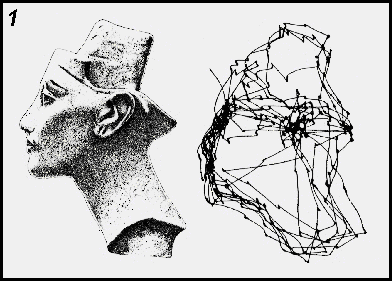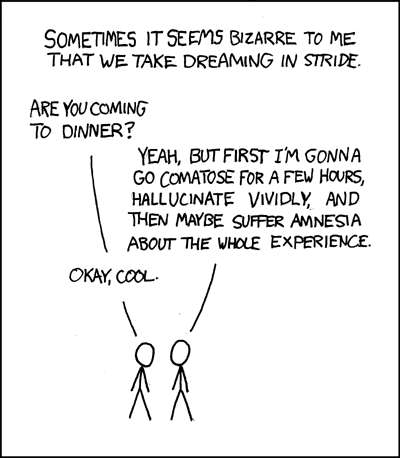Everyone can relate to this. You're in class, at work, waiting for something... you look at the clock and that first second that goes by seems to take forever. Then every second after that appears to progress normally. Why is that?
This is due to a phenomenon called saccadic masking or saccadic suppression. A saccade is the rapid movement of your eyes from one point of attention to another. To demonstrate this to yourself, hold out your two thumbs in front of you, and try to move your eyes smoothly from your right thumb to your left. You'll notice that your eyes don't move smoothly. Instead, they jump to points between your two thumbs along the way.
Saccades allow us to make a mental map of our surroundings and all the points of interest within it. This is because the part of your retina directly behind your pupil, the fovea is packed with receptors that enhance visual acuity.
| Cross-section of the eye, Wikimedia. |
When you look around, your eyes don't span smoothly across the scene in front of you. Instead they move in saccades, quickly directing your fovea from one object of interest (the sharp corner of that table that you don't want to walk into) to another (that cute guy/girl waiting for you at the other end of the room). Saccades also occur when focusing on the details of a single image, as demonstrated by these eye movement traces of subjects as they examined the bust of Nefertiti.
 |
| Source: MIT |
What you don't notice in between these saccades is well, anything. The saccade itself is so fast that your brain doesn't have enough time to process the information coming to it to make a clear image. A blurry image isn't too helpful and would probably just give you motion sickness. In fact, the shaky "hand-held" camera effects in the movie Cloverfield did just that to many of its viewers.
So then what does your brain do with the information sent to it during a saccade? Nothing; this is what is meant by the terms, saccadic suppression and saccadic masking mentioned earlier. Even though the eyes are sending information to the brain, the brain does not process the information, leaving you effectively blind during a saccade. However, saccades are not so fast that you wouldn't notice the lapse in vision. What's going on? You don't actually perceive being blind during a saccade but you also don't see the blurry image, so what are you seeing?
It turns out that once you've fixed your fovea on an object, your brain actually tells you that you've been looking at it from the beginning of the saccade. You don't notice this difference in timing at all, unless of course that object of your gaze actually keeps time. So even though you're focused on the clock for only a second, your brain is telling you that you've been focusing on the clock for the 1,000 milliseconds it takes the second hand to move plus the time it took for your eyes to move to the clock.
On average, a saccade takes about 100 milliseconds, or about 10% of one second. So if you happen to look at a clock right at the beginning of a new second, it will appear to take 10% longer than normal, resulting in the famous illusion known as Chronostasis, or the stopped clock illusion.
